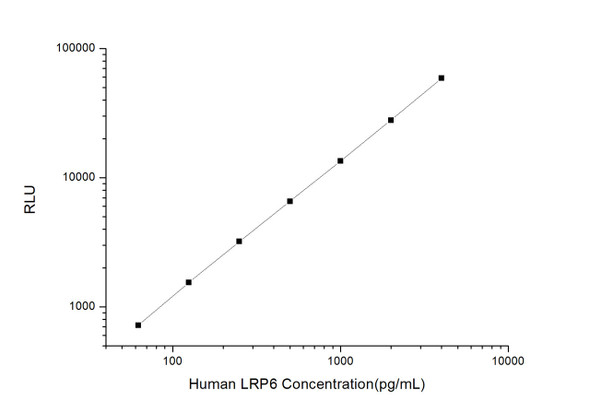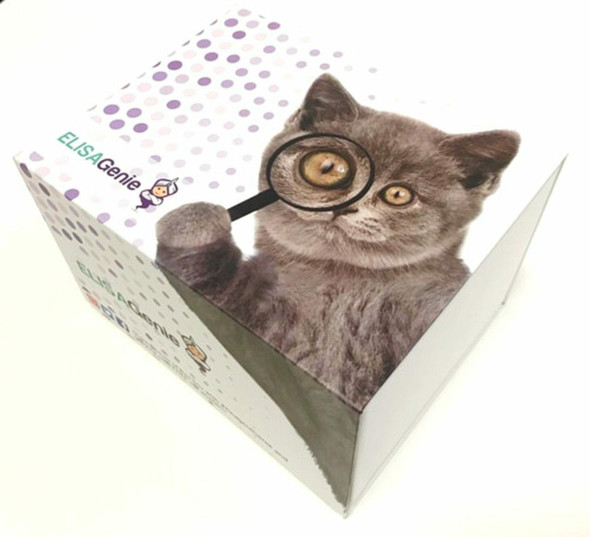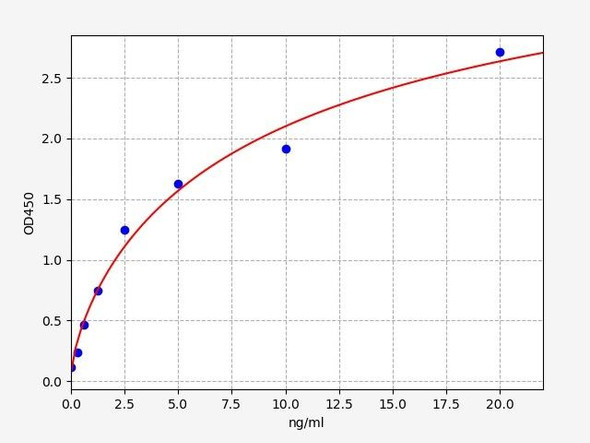Description
Mouse Low-density lipoprotein receptor-related protein 6 (Lrp6) ELISA Kit
The Mouse Low Density Lipoprotein Receptor-Related Protein 6 (LRP6) ELISA Kit is a highly sensitive and specific assay designed for the quantification of LRP6 levels in mouse serum, plasma, and cell culture supernatants. This kit offers accurate and reproducible results, making it an essential tool for researchers studying the functions and implications of LRP6 in various biological processes.LRP6 is a critical component of the Wnt signaling pathway, playing a key role in cell growth, tissue regeneration, and development.
Dysregulation of LRP6 has been linked to various diseases including cancer, osteoporosis, and Alzheimer's disease, highlighting its significance as a potential therapeutic target.With its reliable performance and ease of use, the Mouse LRP6 ELISA Kit is a valuable asset for research projects aimed at elucidating the molecular mechanisms and therapeutic potential of LRP6 in health and disease.
| Product Name: | Mouse Low-density lipoprotein receptor-related protein 6 (Lrp6) ELISA Kit |
| SKU: | MOEB0719 |
| Size: | 96T |
| Target: | Mouse Low-density lipoprotein receptor-related protein 6 (Lrp6) |
| Synonyms: | LRP-6 |
| Assay Type: | Sandwich |
| Detection Method: | ELISA |
| Reactivity: | Mouse |
| Detection Range: | 0.625-40ng/mL |
| Sensitivity: | 0.312ng/mL |
| Intra CV: | 6.8% | ||||||||||||||||||||
| Inter CV: | 8.8% | ||||||||||||||||||||
| Linearity: |
| ||||||||||||||||||||
| Recovery: |
| ||||||||||||||||||||
| Function: | Component of the Wnt-Fzd-LRP5-LRP6 complex that triggers beta-catenin signaling through inducing aggregation of receptor-ligand complexes into ribosome-sized signalsomes. Cell-surface coreceptor of Wnt/beta-catenin signaling, which plays a pivotal role in bone formation. The Wnt-induced Fzd/LRP6 coreceptor complex recruits DVL1 polymers to the plasma membrane which, in turn, recruits the AXIN1/GSK3B-complex to the cell surface promoting the formation of signalsomes and inhibiting AXIN1/GSK3-mediated phosphorylation and destruction of beta-catenin. Required for posterior patterning of the epiblast during gastrulation. |
| Uniprot: | O88572 |
| Sample Type: | Serum, plasma, tissue homogenates, cell culture supernates and other biological fluids |
| Specificity: | Natural and recombinant mouse Low-density lipoprotein receptor-related protein 6 |
| Sub Unit: | Homodimer; disulfide-linked (By similarity). Forms phosphorylated oligomer aggregates on Wnt-signaling (By similarity). Component of the Wnt-Fzd-LRP5-LRP6 complex. Interacts (via the extracellular domain) with WNT1; the interaction is enhanced by prior formation of the Wnt/Fzd complex. Interacts (via the beta-propeller regions 3 and 4) with WNT3A. Interacts (via the beta-propeller regions 1 and 2) with WNT9B. Interacts with FZD5; the interaction forms a coreceptor complex for Wnt signaling and is inhibited by DKK1 and DRAXIN. Interacts (via beta propeller region) with DKK1; the interaction inhibits FZD5/LRP6 complex formation. Interacts with DKK2. Interacts (via the phosphorylated PPPSP motifs) with AXIN1; the interaction recruits the AXIN1/GSK3B complex to cell surface LRP6 signalsomes. Interacts (via the extracellular domain) with RSPO1; the interaction activates Wnt/beta-catenin signaling. Interacts (via the extracellular domain) with RSPO3 (via the cysteine rich domain); the interaction activates Wnt/beta-catenin signaling. Interacts (via the beta-propeller regions 1 and 2) with SOST; the interaction competes with DKK1 for binding for inhibiting beta-catenin signaling. Interacts (via the cytoplasmic domain) with CSNKIE; the interaction phosphorylates LRP6, binds AXIN1 and inhibits AXIN1/GSK3B-mediated phosphorylation of beta-catenin (By similarity). Interacts with DRAXIN; the interaction inhibits Wnt signaling. Interacts with GRB10; the interaction prevents AXIN1 binding, thus negatively regulating the Wnt signaling pathway. Interacts with MESD; the interaction prevents the formation of LRP6 aggregates and targets LRP6 to the plasma membrane. Interacts with MACF1. Interacts with DAB2; the interaction involves LRP6 phosphorylation by CK2 and sequesters LRP6 towards clathrin-mediated endocytosis. Interacts with TMEM198 (By similarity). Interacts with CAPRIN2; the interaction promotes LRP6 phosphorylation at Ser-1490 (By similarity). Found in a complex with CAPRIN2, CCNY and CDK14 during G2/M stage; CAPRIN2 functions as a scaffold for the complex by binding to CCNY via its N terminus and to CDK14 via its C terminus. Interacts with LYPD6. |
| Research Area: | Cancer |
| Subcellular Location: | Cell membrane Single-pass type I membrane protein Endoplasmic reticulum Membrane raft On Wnt signaling, undergoes a cycle of caveolin- or clathrin-mediated endocytosis and plasma membrane location. Released from the endoplasmic reticulum on palmitoylation. Mono-ubiquitination retains it in the endoplasmic reticulum in the absence of palmitoylation. On Wnt signaling, phosphorylated, aggregates and colocalizes with AXIN1 and GSK3B at the plasma membrane in LRP6-signalsomes (By similarity). Chaperoned to the plasma membrane by MESD. |
| Storage: | Please see kit components below for exact storage details |
| Note: | For research use only |
| UniProt Protein Function: | LRP6: Component of the Wnt-Fzd-LRP5-LRP6 complex that triggers beta-catenin signaling through inducing aggregation of receptor- ligand complexes into ribosome-sized signalsomes. Cell-surface coreceptor of Wnt/beta-catenin signaling, which plays a pivotal role in bone formation. The Wnt-induced Fzd/LRP6 coreceptor complex recruits DVL1 polymers to the plasma membrane which, in turn, recruits the AXIN1/GSK3B-complex to the cell surface promoting the formation of signalsomes and inhibiting AXIN1/GSK3- mediated phosphorylation and destruction of beta-catenin. Required for posterior patterning of the epiblast during gastrulation. Homodimer; disulfide-linked. Forms phosphorylated oligomer aggregates on Wnt-signaling. Forms a WNT-signaling complex formed of a WNT protein, a FZD protein and LRP5 or LRP6. Interacts (via the extracellular domain) with WNT1; the interaction is enhanced by prior formation of the Wnt/Fzd complex. Interacts (via the beta-propeller regions 3 and 4) with WNT3A. Interacts (via the beta-propeller regions 1 and 2) with WNT9B. Interacts with FZD5; the interaction forms a coreceptor complex for Wnt signaling and is inhibited by DKK1 and C1orf187. Interacts (via beta propeller region) with DKK1; the interaction inhibits FZD5/LRP6 complex formation. Interacts with DKK2. Interacts with C1orf187/DRAXIN; the interaction inhibits Wnt signaling. Interacts (via the phosphorylated PPPSP motifs) with AXIN1; the interaction recruits the AXIN1/GSK3B complex to cell surface LRP6 signalsomes. Interacts with GRB10; the interaction prevents AXIN1 binding, thus negatively regulating the Wnt signaling pathway. Interacts (via the extracellular domain) with RSPO1; the interaction activates Wnt/beta-catenin signaling. Interacts (via the extracellular domain) with RSPO3 (via the cysteine rich domain); the interaction activates Wnt/beta-catenin signaling. Interacts (via the beta- propeller regions 1 and 2) with SOST; the interaction competes with DKK1 for binding for inhibiting beta-catenin signaling. Interacts with MESD; the interaction prevents the formation of LRP6 aggregates and targets LRP6 to the plasma membrane. Interacts (via the cytoplasmic domain) with CSNKIE; the interaction phosphorylates LRP6, binds AXIN1 and inhibits AXIN1/GSK3B-mediated phosphorylation of beta-catenin. Interacts with MACF1. Decreased levels on WNT3A stimulation. Widely co-expressed with LRP5 during embryogenesis and in adult tissues. Belongs to the LDLR family. |
| UniProt Protein Details: | Protein type:Receptor, misc.; Membrane protein, integral Chromosomal Location of Human Ortholog: 12p13.2 Cellular Component: Golgi apparatus; cell surface; endoplasmic reticulum; early endosome; extracellular region; integral to membrane; caveola; cell soma; early endosome membrane; plasma membrane; synapse; cytoplasmic vesicle; receptor complex Molecular Function:low-density lipoprotein receptor activity; identical protein binding; Wnt-protein binding; Wnt receptor activity; protein binding; protein homodimerization activity; kinase inhibitor activity; frizzled binding; toxin transporter activity; apolipoprotein binding; receptor binding Biological Process: radial glial cell differentiation in the forebrain; regulation of fat cell differentiation; positive regulation of apoptosis; positive regulation of transcription, DNA-dependent; cerebellum morphogenesis; Wnt receptor signaling pathway through beta-catenin; embryonic pattern specification; bone remodeling; Wnt receptor signaling pathway in forebrain neuroblast division; anterior/posterior pattern formation; cell-cell adhesion; elevation of cytosolic calcium ion concentration; response to folic acid; convergent extension; positive regulation of mesenchymal cell proliferation; midbrain development; embryonic limb morphogenesis; external genitalia morphogenesis; neural crest formation; positive regulation of cell cycle; negative regulation of fat cell differentiation; midbrain-hindbrain boundary development; negative regulation of protein kinase activity; positive regulation of transcription from RNA polymerase II promoter; positive regulation of transcription factor activity; cerebral cortex development; embryonic digit morphogenesis; regulation of ossification; embryonic forelimb morphogenesis; response to peptide hormone stimulus; thalamus development; palate development; embryonic hindlimb morphogenesis; synaptic transmission; negative regulation of protein amino acid phosphorylation; positive regulation of bone resorption; heart looping; neural crest cell differentiation; cell migration involved in gastrulation; negative regulation of epithelial cell proliferation; Wnt receptor signaling pathway; gastrulation with mouth forming second; positive regulation of ossification; odontogenesis of dentine-containing teeth; formation of radial glial scaffolds; cerebral cortex cell migration; embryonic retina morphogenesis in camera-type eye; neural tube closure; embryonic camera-type eye morphogenesis Disease: Coronary Artery Disease, Autosomal Dominant 2 |
| NCBI Summary: | This gene encodes a member of the low density lipoprotein (LDL) receptor gene family. LDL receptors are transmembrane cell surface proteins involved in receptor-mediated endocytosis of lipoprotein and protein ligands. The protein encoded by this gene functions as a receptor or, with Frizzled, a co-receptor for Wnt and thereby transmits the canonical Wnt/beta-catenin signaling cascade. Through its interaction with the Wnt/beta-catenin signaling cascade this gene plays a role in the regulation of cell differentiation, proliferation, and migration and the development of many cancer types. This protein undergoes gamma-secretase dependent RIP- (regulated intramembrane proteolysis) processing but the precise locations of the cleavage sites have not been determined.[provided by RefSeq, Dec 2009] |
| UniProt Code: | O88572 |
| NCBI GenInfo Identifier: | 148727288 |
| NCBI Gene ID: | 4040 |
| NCBI Accession: | NP_002327.2 |
| UniProt Secondary Accession: | O88572,O88572, |
| UniProt Related Accession: | O75581 |
| Molecular Weight: | 180,429 Da |
| NCBI Full Name: | low-density lipoprotein receptor-related protein 6 |
| NCBI Synonym Full Names: | low density lipoprotein receptor-related protein 6 |
| NCBI Official Symbol: | LRP6 |
| NCBI Official Synonym Symbols: | ADCAD2 |
| NCBI Protein Information: | low-density lipoprotein receptor-related protein 6; LRP-6 |
| UniProt Protein Name: | Low-density lipoprotein receptor-related protein 6 |
| Protein Family: | Low-density lipoprotein receptor-related protein |
| UniProt Gene Name: | LRP6 |
| UniProt Entry Name: | LRP6_HUMAN |
| Component | Quantity (96 Assays) | Storage |
| ELISA Microplate (Dismountable) | 8×12 strips | -20°C |
| Lyophilized Standard | 2 | -20°C |
| Sample Diluent | 20ml | -20°C |
| Assay Diluent A | 10mL | -20°C |
| Assay Diluent B | 10mL | -20°C |
| Detection Reagent A | 120µL | -20°C |
| Detection Reagent B | 120µL | -20°C |
| Wash Buffer | 30mL | 4°C |
| Substrate | 10mL | 4°C |
| Stop Solution | 10mL | 4°C |
| Plate Sealer | 5 | - |
Other materials and equipment required:
- Microplate reader with 450 nm wavelength filter
- Multichannel Pipette, Pipette, microcentrifuge tubes and disposable pipette tips
- Incubator
- Deionized or distilled water
- Absorbent paper
- Buffer resevoir
*Note: The below protocol is a sample protocol. Protocols are specific to each batch/lot. For the correct instructions please follow the protocol included in your kit.
Allow all reagents to reach room temperature (Please do not dissolve the reagents at 37°C directly). All the reagents should be mixed thoroughly by gently swirling before pipetting. Avoid foaming. Keep appropriate numbers of strips for 1 experiment and remove extra strips from microtiter plate. Removed strips should be resealed and stored at -20°C until the kits expiry date. Prepare all reagents, working standards and samples as directed in the previous sections. Please predict the concentration before assaying. If values for these are not within the range of the standard curve, users must determine the optimal sample dilutions for their experiments. We recommend running all samples in duplicate.
| Step | |
| 1. | Add Sample: Add 100µL of Standard, Blank, or Sample per well. The blank well is added with Sample diluent. Solutions are added to the bottom of micro ELISA plate well, avoid inside wall touching and foaming as possible. Mix it gently. Cover the plate with sealer we provided. Incubate for 120 minutes at 37°C. |
| 2. | Remove the liquid from each well, don't wash. Add 100µL of Detection Reagent A working solution to each well. Cover with the Plate sealer. Gently tap the plate to ensure thorough mixing. Incubate for 1 hour at 37°C. Note: if Detection Reagent A appears cloudy warm to room temperature until solution is uniform. |
| 3. | Aspirate each well and wash, repeating the process three times. Wash by filling each well with Wash Buffer (approximately 400µL) (a squirt bottle, multi-channel pipette,manifold dispenser or automated washer are needed). Complete removal of liquid at each step is essential. After the last wash, completely remove remaining Wash Buffer by aspirating or decanting. Invert the plate and pat it against thick clean absorbent paper. |
| 4. | Add 100µL of Detection Reagent B working solution to each well. Cover with the Plate sealer. Incubate for 60 minutes at 37°C. |
| 5. | Repeat the wash process for five times as conducted in step 3. |
| 6. | Add 90µL of Substrate Solution to each well. Cover with a new Plate sealer and incubate for 10-20 minutes at 37°C. Protect the plate from light. The reaction time can be shortened or extended according to the actual color change, but this should not exceed more than 30 minutes. When apparent gradient appears in standard wells, user should terminatethe reaction. |
| 7. | Add 50µL of Stop Solution to each well. If color change does not appear uniform, gently tap the plate to ensure thorough mixing. |
| 8. | Determine the optical density (OD value) of each well at once, using a micro-plate reader set to 450 nm. User should open the micro-plate reader in advance, preheat the instrument, and set the testing parameters. |
| 9. | After experiment, store all reagents according to the specified storage temperature respectively until their expiry. |
When carrying out an ELISA assay it is important to prepare your samples in order to achieve the best possible results. Below we have a list of procedures for the preparation of samples for different sample types.
| Sample Type | Protocol |
| Serum | If using serum separator tubes, allow samples to clot for 30 minutes at room temperature. Centrifuge for 10 minutes at 1,000x g. Collect the serum fraction and assay promptly or aliquot and store the samples at -80°C. Avoid multiple freeze-thaw cycles. If serum separator tubes are not being used, allow samples to clot overnight at 2-8°C. Centrifuge for 10 minutes at 1,000x g. Remove serum and assay promptly or aliquot and store the samples at -80°C. Avoid multiple freeze-thaw cycles. |
| Plasma | Collect plasma using EDTA or heparin as an anticoagulant. Centrifuge samples at 4°C for 15 mins at 1000 × g within 30 mins of collection. Collect the plasma fraction and assay promptly or aliquot and store the samples at -80°C. Avoid multiple freeze-thaw cycles. Note: Over haemolysed samples are not suitable for use with this kit. |
| Urine & Cerebrospinal Fluid | Collect the urine (mid-stream) in a sterile container, centrifuge for 20 mins at 2000-3000 rpm. Remove supernatant and assay immediately. If any precipitation is detected, repeat the centrifugation step. A similar protocol can be used for cerebrospinal fluid. |
| Cell culture supernatant | Collect the cell culture media by pipette, followed by centrifugation at 4°C for 20 mins at 1500 rpm. Collect the clear supernatant and assay immediately. |
| Cell lysates | Solubilize cells in lysis buffer and allow to sit on ice for 30 minutes. Centrifuge tubes at 14,000 x g for 5 minutes to remove insoluble material. Aliquot the supernatant into a new tube and discard the remaining whole cell extract. Quantify total protein concentration using a total protein assay. Assay immediately or aliquot and store at ≤ -20 °C. |
| Tissue homogenates | The preparation of tissue homogenates will vary depending upon tissue type. Rinse tissue with 1X PBS to remove excess blood & homogenize in 20ml of 1X PBS (including protease inhibitors) and store overnight at ≤ -20°C. Two freeze-thaw cycles are required to break the cell membranes. To further disrupt the cell membranes you can sonicate the samples. Centrifuge homogenates for 5 mins at 5000xg. Remove the supernatant and assay immediately or aliquot and store at -20°C or -80°C. |
| Tissue lysates | Rinse tissue with PBS, cut into 1-2 mm pieces, and homogenize with a tissue homogenizer in PBS. Add an equal volume of RIPA buffer containing protease inhibitors and lyse tissues at room temperature for 30 minutes with gentle agitation. Centrifuge to remove debris. Quantify total protein concentration using a total protein assay. Assay immediately or aliquot and store at ≤ -20 °C. |
| Breast Milk | Collect milk samples and centrifuge at 10,000 x g for 60 min at 4°C. Aliquot the supernatant and assay. For long term use, store samples at -80°C. Minimize freeze/thaw cycles. |










